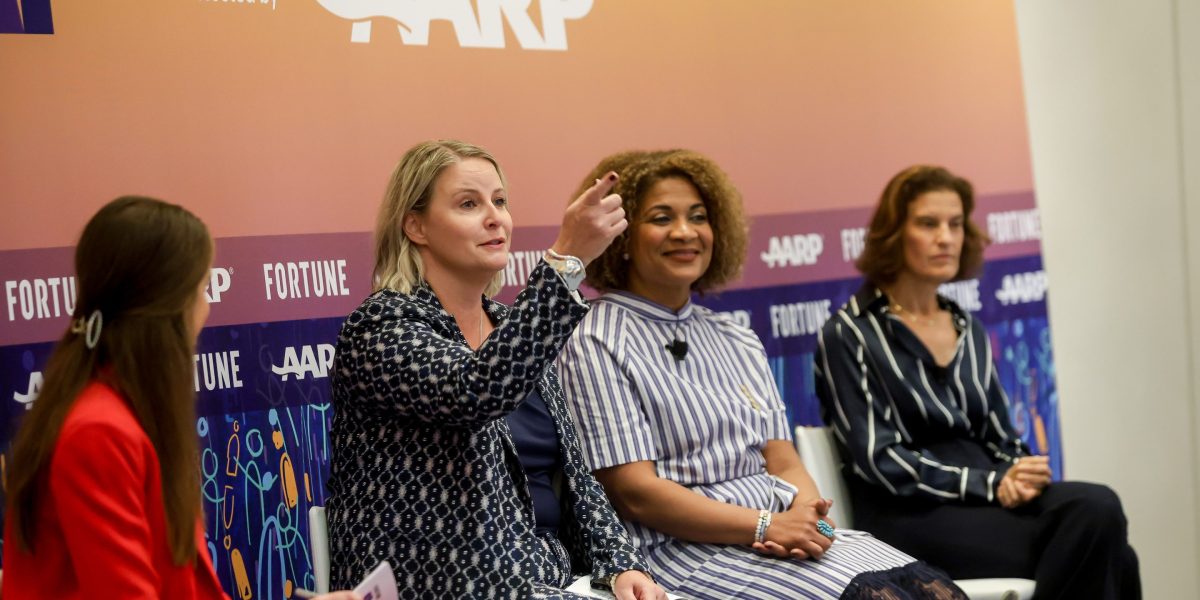Women are reclaiming many once-taboo topics about their health, and two go hand-in-hand: aging and menopause. With more women like Melinda French Gates talking about aging as something to be celebrated, it’s becoming easier to see how women can thrive as they age with the right health care, mindset, and support system.
The women leading these conversations spoke to Fortune at its Most Powerful Women Summit on Tuesday, deepening awareness for sex- and age-based discrimination while normalizing discussions about making the second half of women’s lives as healthy and fulfilling as possible. Executive leaders in health care said the following are things to look out for as you age.
1. Hormone replacement therapy is key to menopause treatment
Menopause is a time of intense hormonal, emotional, and physical changes for women, often accepted to be universally terrible. Joanna Strober, cofounder and CEO of Midi Health, a menopause care company, wants women to feel in control of a time that largely feels out of their control.
“While perimenopause and menopause is inevitable, suffering is not,” Strober told Fortune at the MPW Summit. “You don’t have to suffer through this time. And for me, that is incredibly empowering.”
Women could be living with menopausal symptoms including brain fog, sleep disturbance, anxiety, and depression, Strober said, which are all related to estrogen levels. “There’s like 65 symptoms that are related to estrogen changing,” she said.
Strober said that 85% of women will have severe menopause symptoms, and for 90% of those women, hormone replacement therapy is the answer. “That means 75% of women in perimenopause and menopause should be on hormone replacement therapy,” Strober said. Yet only 1.8% of women are, she added.
“There is so much misinformation and fear and lack of knowledge. And the doctors have that too, which means that women are just not getting the right treatments,” Strober said. “If you deny them the one treatment that is best for them, then you really are denying them the ability to thrive.”
2. Age discrimination is real—and bad for the workplace
Women of all ages are a core part of the workforce, with more older people working than ever before, said Debra Whitman, executive vice president and chief public policy officer at AARP and author of The Second Fifty: Answers to the 7 Big Questions of Midlife and Beyond, at the MPW Summit.
Yet these women face ageism that pushes them out of jobs—income they need as they age due to gender and race-based pay gaps that leave them with less money in the long run, Whitman said.
“So many women have to work longer,” Whitman told Fortune. “Age discrimination is pretty real and it affects women more. Ageism times sexism equals loss.”
Whitman has found that workforces thrive with multigenerational teams. Not only are age-diverse teams more productive, according to Whitman, but people actually want to work with people of all ages.
“This is the first time that we have five generations working together,” Whitman said. She encouraged leaders to create workplaces that foster more multigenerational engagement, while ensuring that older workers are not being pushed out. This is especially important for aging women, who historically have dealt with lower incomes and more difficulty in being hired.
Age discrimination is not just bad for the women who face it, but for the economy as well, Whitman said. With an aging population and declining birth rates, it is inevitable that the workforce will include and need older adults.
“We’re going to need older workers,” Whitman said.
3. Friends are a ‘health benefit’
Loneliness and isolation can be detrimental for older adults. Fatima Goss Graves, president and CEO of the National Women’s Law Center, says we should treat friendships as a “health benefit.”
Graves frequently sends her parents a study showing how spending time with your grandchildren reduces your risk of cognitive decline. Meanwhile, Whitman cited one of the largest Harvard studies which found that participants with the best health and aging outcomes “had really strong relationships and friendships” throughout their lives.
Graves said support is especially important for the sandwich generation that tries to balance caring for aging parents and children.
Graves told Fortune that part of being able to live longer is having practical ideas and solutions that make aging less scary, which will take the pressure off of those trying to balance caregiving for children, parents, and themselves as they age too. “It’s alleviating that deep stress that people are experiencing every day that’s sort of unacknowledged, unaddressed and not discussed.”
For more on Most Powerful Women:

